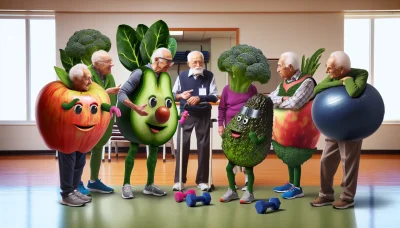Peripheral artery disease heart-healthy diet Quiz
Test Your Knowledge
Question of
Understanding Peripheral Artery Disease (PAD)
What is Peripheral Artery Disease?
Peripheral Artery Disease (PAD) is a common circulatory problem where narrowed arteries reduce blood flow to the limbs. PAD often causes leg pain during walking and can be a sign of more widespread arterial disease. It's vital to understand PAD as it can lead to severe complications if left untreated.
The primary causes of PAD are atherosclerosis and plaque buildup in the arteries. This condition is often linked with smoking, diabetes, hypertension, and high cholesterol levels. Recognizing these risk factors early can be crucial in preventing or managing PAD effectively.
Key symptoms to recognize include leg pain or cramps during physical activities, which typically goes away with rest. Other signs may include numbness, weakness, or coldness in the lower legs or feet. If you notice any of these symptoms, it's time to take action!
The Impact of Diet on PAD
The food you eat plays a significant role in the progression of PAD. A diet high in saturated fats and cholesterol can worsen the condition by contributing to artery blockages. Conversely, adopting a nutritious diet can help manage PAD symptoms and improve overall vascular health.
Certain foods can aggravate PAD symptoms by increasing inflammation or plaque formation within arteries. These include processed foods, excessive salt intake, and trans fats found in many fried and baked goods.
A heart-healthy diet offers immense benefits for those with PAD. Foods rich in omega-3 fatty acids, fiber, and antioxidants should be on your plate! They promote good circulation and reduce inflammation, helping to keep those arteries clear!
- Avoid processed meats: Opt for lean proteins instead.
- Limited salt intake: Too much salt can raise blood pressure.
- Incorporate more fruits and vegetables: They're packed with essential nutrients.
- Select whole grains over refined: They help maintain healthy blood vessels.
- Moderate alcohol consumption: Excessive drinking can lead to health issues.
- Maintain hydration: Water is key for overall cardiovascular health.
Diagnosing PAD
To detect PAD, healthcare providers use several medical tests. The Ankle-Brachial Index (ABI) is a common non-invasive test that compares blood pressure in the ankle with blood pressure in the arm. Other tests may include ultrasound imaging, angiography, or blood tests for additional insight into arterial health.
Interpreting the results of these tests is crucial for a proper diagnosis. An ABI ratio of less than one indicates some degree of blockage in the peripheral arteriesa red flag that requires attention from both you and your healthcare team.
If you suspect you have symptoms of PAD or are at risk due to other health conditions, consult a healthcare professional without delay. Early diagnosis means better management options and outcomesdon't wait until it's too late!
Fundamentals of a Heart-Healthy Diet
Key Components of a Heart-Healthy Diet
The cornerstone of a heart-healthy diet is the abundance of fruits and vegetables. These are powerhouses of essential nutrients, vitamins, and fiber, which contribute to cardiovascular health. A colorful variety of produce ensures a broad range of antioxidants and phytochemicals that protect your heart.
Whole grains are another pillar, providing necessary fiber that helps in reducing cholesterol levels and maintaining blood pressure. Swapping out refined grains for whole ones can significantly improve heart health. Look for whole wheat, brown rice, oats, and quinoa to incorporate into meals.
Choosing the right proteins is crucial; lean meats, fish rich in omega-3 fatty acids, legumes, and nuts should be staples. These proteins contain less saturated fat and provide additional nutrients beneficial for heart function.
Understanding Fats and Cholesterol
Not all fats are villains in the story of heart health. Monounsaturated and polyunsaturated fatsfound in olive oil, avocados, and certain nutsare beneficial. They can help lower bad cholesterol levels and reduce the risk of heart disease when consumed in moderation.
Diet plays a pivotal role in managing cholesterol levels. Foods high in soluble fiber like oats can help manage cholesterol naturally. Meanwhile, trans fats found in many processed foods should be avoided as they increase bad cholesterol and reduce good cholesterol.
Reading nutrition labels is essential for maintaining a heart-healthy diet. Pay attention to serving sizes, the amount of saturated fat, trans fat, and sodium content to make informed choices that contribute to cardiovascular wellness.
Hydration and Heart Health
Adequate water intake is vital for heart health as it aids in the maintenance of blood volume, allowing the heart to pump more efficiently. Dehydration can lead to higher heart rates and blood pressure issues.
Alcohol and caffeine have significant effects on peripheral artery disease (PAD) and overall cardiovascular health. Moderation is key as excessive intake can lead to adverse outcomes like increased heart rate or high blood pressure.
- Maintain a Water Bottle: Having a water bottle at hand encourages regular sips throughout the day.
- Hydrate with Foods: Consuming water-rich foods like cucumbers or watermelon contributes to hydration.
- Avoid Sugary Drinks: Opt for water or herbal teas over sugary sodas which offer no nutritional benefit.
- Leverage Technology: Use apps or reminders to prompt regular water intake throughout your day.
- Beware of Overhydration: While rare, too much water intake can disrupt electrolyte balance drink when you're thirsty.
- Monitor Urine Color: It's a simple indicator; pale yellow suggests adequate hydration whereas dark indicates you need more fluids.
- Prioritize Hydration Pre & Post Exercise: Replenishing fluids lost through sweat is crucial around physical activities.
Foods to Include in Your Diet for PAD
Anti-Inflammatory Foods
Incorporating anti-inflammatory foods into your diet can play a crucial role in managing Peripheral Artery Disease (PAD). These foods help reduce vascular inflammation, a key factor in the progression of PAD. Integrating these dietary choices can lead to improved blood flow and reduced symptoms.
Benefits of Omega-3 Fatty Acids
Omega-3 fatty acids are known for their profound anti-inflammatory effects, which are incredibly beneficial for individuals with PAD. Regular consumption of omega-3s can help diminish plaque buildup in arteries, enhancing circulation. Fatty fish like salmon and mackerel are excellent sources of these essential nutrients.
Sources of Antioxidants
Antioxidants play a pivotal role in combating oxidative stress, which is linked to arterial damage. Foods rich in antioxidants, such as blueberries, dark chocolate, and green tea, can provide defense against cellular damage and support vascular health.
Role of Fiber in Reducing Inflammation
Fiber isn't just good for digestion; it's also instrumental in reducing inflammation associated with PAD. A diet high in fiber from whole grains, fruits, and vegetables can help lower cholesterol levels and promote better blood flow.
Nutrient-Dense Food Choices
Importance of Vitamins and Minerals
Vitamins and minerals are the cornerstones of a nutrient-dense diet, vital for maintaining overall health and supporting circulatory function. They aid in repairing tissues and preventing inflammation, which is why a diet rich in these nutrients is recommended for those with PAD.
Identifying Nutrient-Rich Foods
To maximize the intake of vitamins and minerals, focus on including a variety of colorful fruits and vegetables, lean proteins, whole grains, and low-fat dairy products. These items pack a nutritional punch that supports arterial health.
- Planning Balanced Meals for Optimal Nutrition: - Include a variety of food groups at each meal. - Aim for colorful plates more colors often mean a broader range of nutrients. - Opt for whole foods over processed items. - Monitor portion sizes to avoid overeating. - Stay hydrated with water rather than sugary drinks. - Limit sodium intake to maintain healthy blood pressure levels. - Choose cooking methods like steaming or grilling over frying. - Plan meals ahead to ensure you're including all necessary food groups. - Consider consulting with a nutritionist or dietitian for personalized advice.
Superfoods for Circulatory Health
Benefits of Garlic and Onions
Garlic and onions are not just flavor enhancers; they're also superfoods with potent benefits for circulatory health. They contain compounds that encourage healthy blood vessels and may even help lower blood pressure.
Power of Berries and Leafy Greens
Berries are loaded with antioxidants that protect your arteries, while leafy greens provide nitrates that convert to nitric oxide, essential for blood vessel flexibility. Integrating these foods into your diet can contribute significantly to improving PAD symptoms.
Advantages of Nuts and Seeds
Nuts and seeds are excellent sources of healthy fats, fiber, vitamins, and minerals. Including them in your diet can enhance endothelial function, leading to improved arterial healtha win-win for those combatting PAD!
Foods to Avoid or Limit with PAD
High-Sodium Foods and PAD Risk
Identifying High-Sodium Foods is crucial for individuals managing Peripheral Artery Disease (PAD). These foods can sneak into your diet through processed meals, canned goods, and even some seemingly healthy snacks. Always check food labels for sodium content and be aware of the sodium levels in restaurant dishes.
The Effects of Excess Sodium on Blood Pressure are well-documented. High-sodium diets contribute to hypertension, a significant risk factor for PAD. Elevated blood pressure can damage arteries over time, exacerbating the effects of PAD and leading to more severe health issues.
Here are some essential Tips for Reducing Sodium Intake:
- Cook at home using fresh ingredients to control the amount of sodium in your meals.
- Choose low-sodium or no-salt-added versions of products like soups, broths, and sauces.
- Rinse canned vegetables and beans under water to wash away some of the added sodium.
- Season food with herbs, spices, citrus, or vinegar instead of salt.
- Be cautious with condiments like soy sauce, ketchup, and salad dressings which are often high in sodium.
Saturated Fats and Trans Fats to Avoid
To understand the Risks of Unhealthy Fats , it's important to know that saturated and trans fats can lead to the buildup of plaque in the arteries. This buildup narrows the arteries, making it harder for blood to flow through and increasing the risk of heart disease alongside PAD.
Common Sources of Saturated and Trans Fats include red meats, full-fat dairy products, fried foods, and many baked goods. Reading food labels is essential as trans fats can appear as "partially hydrogenated oils" an ingredient you want to avoid entirely.
To combat these risks, consider switching to Healthier Alternatives to Unhealthy Fats . Options like olive oil, avocados, nuts, and seeds provide healthier monounsaturated and polyunsaturated fats that support heart health without contributing negatively to PAD symptoms.
Processed Foods and Refined Sugars
The Dangers of Processed Food Consumption are particularly relevant for individuals with PAD. These foods often contain high levels of unhealthy fats, sodium, and sugarsall contributors to arterial health problems. Minimizing intake can help manage PAD symptoms more effectively.
Impact of Refined Sugars on PAD : When you consume excessive amounts of refined sugars found in soft drinks, candies, and pastries, you're not just risking weight gain; you're also potentially increasing inflammation within your body. This inflammation can harm your arteries' health further complicating PAD conditions.
Adopting effective strategies is key for those looking to cut back on these harmful components. Here are some actionable steps for reducing your consumption:
- Eat whole fruits instead of drinking fruit juices or eating sweets they offer natural sugars along with beneficial fibers.
- Avoid stocking up on processed snacks if they aren't readily available at home, you're less likely to eat them.
- Become a label detective learn how sugars might be listed (like high-fructose corn syrup) and steer clear from products that contain them.
- Incorporate more whole grains into your diet over refined carbohydrates; they provide lasting energy without the sugar spike.
Meal Planning and Preparation for PAD Patients
Creating a Balanced Meal Plan
Embarking on a journey to create a balanced meal plan for Peripheral Artery Disease (PAD) patients is an exhilarating first step towards heart health! Setting realistic dietary goals is paramount. By focusing on nutrient-dense foods that improve circulation, PAD patients can manage their symptoms effectively. Remember, consistency is key!
Diving into sample meal plans specifically tailored for PAD patients can be a game-changer. These plans typically emphasize fruits, vegetables, whole grains, and lean proteins while minimizing saturated fats and sodium. It's not just a diet; it's a lifestyle shift that promises to revitalize your body!
Adapting family meals for heart health doesn't have to be a bland affair. On the contrary, it's an exciting opportunity to explore new recipes and ingredients! Making minor tweaks to favorite dishes can ensure they're both delicious and heart-healthy, keeping the entire family on board.
Cooking Techniques for Better Heart Health
Unleash the power of healthy cooking methods! Steaming, grilling, baking, and poaching are your new best friends in the kitchen. These techniques help retain the integrity of food without adding unnecessary fats, making each meal a heart-healthy feast.
Say goodbye to salt and hello to an array of flavorful herbs and spices! Seasoning without salt opens up a world of taste possibilities while safeguarding your heart. Herbs like rosemary and spices like cumin can transform any dish from mundane to mouthwatering.
Get ready for some smart swaps in the kitchen that will supercharge your PAD management! Replace butter with olive oil, choose whole grains over refined ones, and opt for skinless poultry or fish instead of red meat. These simple substitutions can have a profound impact on your heart health.
Shopping Tips for a Heart-Healthy Pantry
Strategizing with a heart-healthy shopping list before hitting the grocery aisles is crucial. Load up on fresh produce, whole grains, and lean proteins. Don't forget to include heart-friendly oils like olive or avocado oil!
Become a savvy shopper by decoding food labels while grocery shopping. Keep an eye out for hidden sodium, sugars, and unhealthy fats. Knowledge is powerunderstanding what goes into your body is essential for managing PAD.
- Educate Yourself: Learn about nutrient content and serving sizes.
- Check Serving Sizes: Compare them with your dietary needs.
- Sodium Content: Look for low-sodium options to keep blood pressure in check.
- Sugars: Avoid high sugar items that can lead to weight gain.
- Fats: Choose items with healthy fats like monounsaturated and polyunsaturated fats.
- Fiber: High-fiber foods are great for digestion and heart health.
- Additives: Minimize intake of artificial colors, flavors, or preservatives.
- Certifications: Look for stamps of approval from recognized heart associations.
Gearing up your pantry with essentials allows you to whip up quick, healthy meals even on your busiest days. Stock staples such as canned beans, whole-grain pastas, and frozen vegetables so you're always prepared to fuel your body right!
Lifestyle Modifications Alongside Dietary Changes
Exercise Recommendations for PAD Patients
For individuals grappling with Peripheral Artery Disease (PAD), exercise isn't just beneficial; it's a critical component of managing the condition. The right kind of physical activity can enhance circulation, bolster heart health, and mitigate symptoms. It's essential to consult with a healthcare provider to tailor an exercise plan that's both safe and effective.
Safe Exercises for Individuals with PAD : Walking is often hailed as the go-to exercise for PAD patients. It's low-impact, easily modifiable, and can be structured to fit individual endurance levels. Additionally, supervised exercise programs may offer targeted workouts designed to improve walking distance and reduce discomfort during activity.
Building an Exercise Routine for Heart Health : Gradual progression is key when building an exercise routine. Start with short durations and low intensity, then incrementally increase as your body adapts. Incorporating a mix of cardiovascular exercises, strength training, and flexibility activities yields comprehensive benefits.
Overcoming Barriers to Physical Activity with PAD : Many face obstacles such as pain or lack of motivation. To overcome these, setting realistic goals, celebrating small victories, and seeking support from exercise groups or health professionals can be incredibly effective strategies.
Smoking Cessation and Alcohol Moderation
Smoking is a notorious antagonist in the narrative of PAD, exacerbating symptoms and accelerating disease progression. Quitting smoking not only stabilizes the condition but also slashes the risk of other cardiovascular complications.
The Impact of Smoking on PAD : Smoking inflicts direct damage on blood vessels, impeding blood flow which is already compromised in PAD patients. This harmful habit can lead to more frequent and severe symptoms, making cessation an urgent priority.
- Strategies for Quitting Smoking : Success in smoking cessation often requires a multifaceted approach. Consider nicotine replacement therapies, prescription medications, behavioral therapy, and support groups as potential allies in your quest to quit.
- Guidelines for Alcohol Consumption with PAD : Moderate alcohol consumption may have some cardiovascular benefits when done responsibly. However, excessive intake can be detrimental. Adhering to guidelineslimiting to one drink per day for women and two for menis crucial.
Stress Management Techniques
Chronic stress acts as a silent saboteur on cardiovascular health; hence managing stress is indispensable for those with PAD. Understanding this connection empowers individuals to adopt proactive measures in mitigating stress-related risks.
Understanding the Link Between Stress and Heart Health : Stress triggers physiological responses that strain the heart and blood vessels. Over time this can contribute to hypertension and other heart-related issues which are particularly perilous for those with PAD.
Effective stress reduction practices are diverse and can include structured therapies such as cognitive-behavioral therapy or simpler approaches like engaging in hobbies or social activities that bring joy and relaxation.
Incorporating mindfulness and relaxation techniques such as deep breathing exercises, meditation, or yoga into daily routines has been shown to significantly reduce stress levels. These practices encourage a focus on the present moment, fostering a sense of calmness that can protect heart health.
Monitoring Progress and Maintaining a Heart-Healthy Lifestyle
Tracking Your Dietary Changes
Keeping a Food Diary
Maintaining a food diary can be a game-changer in your heart-healthy journey. It allows you to record everything you consume, giving you clear insight into your eating habits. This self-monitoring technique is powerful for identifying patterns, triggers, and opportunities for improvement.
Using Apps and Tools for Diet Monitoring
In this digital age, harnessing the power of apps and online tools for diet monitoring can simplify the process. These platforms offer features like calorie tracking, nutritional information, and personalized feedback to ensure your dietary choices align with your heart-health goals.
Evaluating Your Dietary Habits Over Time
It's crucial to periodically review your eating habits to gauge progress. Look back at your food diary or app data every few weeks to assess how well you're sticking to your dietary goals. Make adjustments as needed to keep moving forward towards a heart-healthy lifestyle.
Regular Check-ups and Communication with Healthcare Providers
Importance of Regular Medical Follow-Up
Regular medical follow-ups are vital for anyone looking to maintain a heart-healthy lifestyle. These check-ups help track your health status, adjust medications if necessary, and catch any emerging issues early on.
Discussing Dietary Changes with Your Doctor
Your healthcare provider should be in the loop about any dietary changes you're considering. Their expertise can guide you towards making choices that complement your overall treatment plan and help prevent potential complications.
- When to Seek Medical Advice:
- If you experience new or worsening symptoms.
- Before making significant changes to your diet or exercise routine.
- If you have concerns about medications or their side effects.
- When you need support in managing chronic conditions like PAD.
- If there's a sudden change in weight without a clear reason.
Staying Motivated and Overcoming Setbacks
Setting Achievable Health Goals
To stay motivated, set realistic and achievable health goals. Break down larger objectives into smaller milestones that can be celebrated along the way. This approach keeps motivation high and makes the journey more rewarding.
Building a Support System
A robust support system is essential when adopting new lifestyle changes. Surround yourself with friends, family, or join support groups who understand your goals and encourage you in times of need. They can provide the extra push to keep going when motivation wanes.
Dealing with Dietary Slip-Ups and Staying on Track
Dietary slip-ups are part of the journey; what matters is how you respond. Don't let minor setbacks derail your entire plan. Acknowledge them, learn from them, and refocus on your long-term heart-health goals with renewed commitment.












